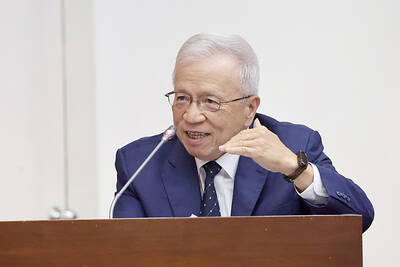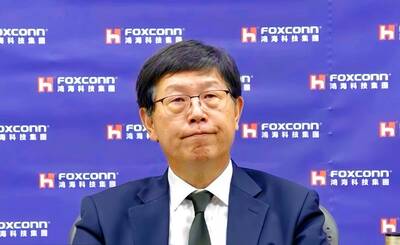Japan is heavily investing in a new kind of ultra-thin, flexible solar panel that it hopes will help it meet renewable energy goals while challenging China’s dominance of the sector.
Pliable perovskite panels are perfect for mountainous Japan, with its shortage of flat plots for traditional solar farms. A key component of the panels is iodine, something Japan produces more of than any country but Chile.
The push faces some obstacles: Perovskite panels contain toxic lead, and, for now, produce less power and have shorter lifespans than their silicon counterparts.

Photo: AFP
Still, with a goal of net zero by 2050 and a desire to break China’s solar supremacy, the Japanese government is offering generous incentives to get industry on board, including a ¥157 billion (US$1.1 billion) subsidy to plastic maker Sekisui Chemical Co for a factory to produce enough perovskite solar panels to generate 100 megawatts by 2027, enough to power 30,000 households.
By 2040, Japan wants to install enough perovskite panels to generate 20 gigawatts of electricity, equivalent to adding about 20 nuclear reactors.
That should help Japan’s target to have renewable energy cover up to 50 percent of electricity demand by 2040.
The nation is looking to solar power, including perovskite and silicon-based solar cells, to cover up to 29 percent of all electricity demand by that time, a sharp rise from 9.8 percent in 2023.
“To increase the amount of renewable energy and achieve carbon neutrality, I think we will have to mobilize all the technologies available,” said Hiroshi Segawa, a specialist in next-generation solar technology at the University of Tokyo.
“Perovskite solar panels can be built domestically, from the raw materials to production to installation. In that sense, they could significantly contribute to things like energy security and economic security,” he said.
Silicon solar panels are made of thin wafers that are processed into cells that generate electricity.
They must be protected by reinforced glass sheets and metal frames, making the final products heavy and cumbersome.
However, perovskite solar cells are created by printing or painting ingredients such as iodine and lead onto surfaces like film or sheet glass.
The final product can be just a millimeter thick and a tenth the weight of a conventional silicon solar cell.
Perovskite panels’ malleability means they can be installed on uneven and curved surfaces, a key feature in Japan, where 70 percent of the country is mountainous.
The panels are already being incorporated into several projects, including a 46-story Tokyo building to be completed by 2028.
The southwestern city of Fukuoka has also said it wants to cover a domed baseball stadium with perovskite panels, while major electronics brand Panasonic Corp is working on integrating perovskite into windowpanes.
“What if all of these windows had solar cells integrated in them?” said Yukihiro Kaneko, general manager of Panasonic’s perovskite photovoltaics development department, gesturing to the glass-covered high-rise buildings surrounding the firm’s Tokyo office.
That would allow power to be generated where it is used, and reduce the burden on the national grid, Kaneko added.
For all the enthusiasm, perovskite panels remain far from mass production.
They are less efficient than their silicon counterparts, and have a lifespan of just a decade, compared with 30 years for conventional units.
The toxic lead they contain also means they need careful disposal after use.
However, the technology is advancing fast. Some prototypes can perform nearly as powerfully as silicon panels and their durability is expected to reach 20 years soon.

JITTERS: Nexperia has a 20 percent market share for chips powering simpler features such as window controls, and changing supply chains could take years European carmakers are looking into ways to scratch components made with parts from China, spooked by deepening geopolitical spats playing out through chipmaker Nexperia BV and Beijing’s export controls on rare earths. To protect operations from trade ructions, several automakers are pushing major suppliers to find permanent alternatives to Chinese semiconductors, people familiar with the matter said. The industry is considering broader changes to its supply chain to adapt to shifting geopolitics, Europe’s main suppliers lobby CLEPA head Matthias Zink said. “We had some indications already — questions like: ‘How can you supply me without this dependency on China?’” Zink, who also

At least US$50 million for the freedom of an Emirati sheikh: That is the king’s ransom paid two weeks ago to militants linked to al-Qaeda who are pushing to topple the Malian government and impose Islamic law. Alongside a crippling fuel blockade, the Group for the Support of Islam and Muslims (JNIM) has made kidnapping wealthy foreigners for a ransom a pillar of its strategy of “economic jihad.” Its goal: Oust the junta, which has struggled to contain Mali’s decade-long insurgency since taking power following back-to-back coups in 2020 and 2021, by scaring away investors and paralyzing the west African country’s economy.

BUST FEARS: While a KMT legislator asked if an AI bubble could affect Taiwan, the DGBAS minister said the sector appears on track to continue growing The local property market has cooled down moderately following a series of credit control measures designed to contain speculation, the central bank said yesterday, while remaining tight-lipped about potential rule relaxations. Lawmakers in a meeting of the legislature’s Finance Committee voiced concerns to central bank officials that the credit control measures have adversely affected the government’s tax income and small and medium-sized property developers, with limited positive effects. Housing prices have been climbing since 2016, even when the central bank imposed its first set of control measures in 2020, Chinese Nationalist Party (KMT) Legislator Lo Ting-wei (羅廷瑋) said. “Since the second half of

AI BOOST: Next year, the cloud and networking product business is expected to remain a key revenue pillar for the company, Hon Hai chairman Young Liu said Manufacturing giant Hon Hai Precision Industry Co (鴻海精密) yesterday posted its best third-quarter profit in the company’s history, backed by strong demand for artificial intelligence (AI) servers. Net profit expanded 17 percent annually to NT$57.67 billion (US$1.86 billion) from NT$44.36 billion, the company said. On a quarterly basis, net profit soared 30 percent from NT$44.36 billion, it said. Hon Hai, which is Apple Inc’s primary iPhone assembler and makes servers powered by Nvidia Corp’s AI accelerators, said earnings per share expanded to NT$4.15 from NT$3.55 a year earlier and NT$3.19 in the second quarter. Gross margin improved to 6.35 percent,